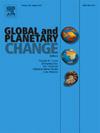Increasing cross-border dust storm from Mongolia to China during 1987–2022
Abstract
Mongolia and northern China have the highest frequency of dust weather in Northeast Asia. Dust transport from Mongolia to China is a major cause of dust weather in northern China. However, there has been limited research on the frequency changes of cross-border dust storms from Mongolia to China over the past few decades. Based on observational data, we analyzed the variation in cross-border dust storms between China and Mongolia during 1987–2022. The results indicate that, on average, approximately seven cross-border dust storm events occur annually between China and Mongolia, predominantly during the spring. The frequency of cross-border dust storms from Mongolia to China significantly increased from 2.2 events in P1 (1987–1999) to 7.5 events in P2 (2000−2022). Long-term trends suggest that rising dust emissions in east-central Mongolia largely contributed to this increase. The increase in cross-border dust storms from Mongolia to China in the spring was driven by more frequent cyclones in eastern Mongolia and Northeast China during P2. This is evidenced by a negative height anomaly and increased vorticity at 850 hPa over Northeast China. The cyclones were linked to the northward shift of the East Asian Polar Front Jet Stream (EAPJ) at 300 hPa between 50°N and 60°N. Additionally, surface conditions such as higher temperatures and decreased vegetation in Mongolia contributed to the increased frequency of cross-border dust storms from P1 to P2.

 求助内容:
求助内容: 应助结果提醒方式:
应助结果提醒方式:


